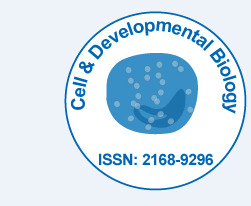
Cell & Developmental Biology
Open Access
ISSN: 2168-9296

ISSN: 2168-9296
Perspective - (2025)Volume 14, Issue 1
The Wnt signaling pathway represents one of the most fundamental and highly conserved regulatory mechanisms controlling embryonic development across metazoan species. This complex signaling network governs critical developmental processes including axis formation, cell fate specification, tissue patterning, and morphogenetic movements. The pathway's central role in development is evidenced by the severe developmental abnormalities that arise from mutations in Wnt signaling components, ranging from early embryonic lethality to specific organ malformations. Understanding the intricate regulation of Wnt signaling has profound implications for developmental biology, regenerative medicine, and cancer research.
The canonical Wnt signaling pathway operates through a well-characterized mechanism involving β-catenin stabilization and transcriptional activation. In the absence of Wnt signals, β- catenin is phosphorylated by the destruction complex, consisting of Axin, Adenomatous Polyposis Coli (APC), Casein Kinase 1 (CK1), and Glycogen Synthase Kinase 3β (GSK3β). This phosphorylation targets β-catenin for ubiquitination and subsequent proteasomal degradation, maintaining low cytoplasmic levels of the protein. Upon Wnt ligand binding to Frizzled receptors and low-density Lipoprotein Receptor-related Protein (LRP) co-receptors, the destruction complex is inhibited, leading to β-catenin stabilization and nuclear translocation. Nuclear β-catenin interacts with T-Cell Factor/Lymphoid Enhancer Factor (TCF/LEF) transcription factors to activate target gene expression.
Non-canonical Wnt signaling pathways operate independently of β-catenin and regulate diverse cellular processes including cell polarity, cytoskeletal organization, and calcium homeostasis. The Planar Cell Polarity (PCP) pathway controls the polarization of cells within the plane of tissues, regulating processes such as convergent extension movements during gastrulation and neural tube closure. Key components of the PCP pathway include Van Gogh-like (Vangl), Dishevelled (Dvl), and prickle proteins, which establish asymmetric protein distributions that define cellular polarity. The Wnt/calcium pathway involves the activation of phospholipase C, leading to calcium release and activation of calcium-dependent signaling cascades that regulate cell adhesion and migration.
The spatial and temporal regulation of Wnt signaling is achieved through multiple mechanisms that ensure precise control of pathway activity. Wnt ligands are secreted glycoproteins that undergo extensive post-translational modifications, including palmitoylation and glycosylation, which are essential for their biological activity. The restricted diffusion of Wnt proteins creates signaling gradients that provide positional information to developing tissues. Wnt signaling is further regulated by numerous secreted antagonists, including Dickkopf (Dkk) proteins, secreted Frizzled-Related Proteins (sFRPs), and Wnt Inhibitory Factor (WIF), which modulate pathway activity through different mechanisms.
During early embryonic development, Wnt signaling plays essential roles in establishing the basic body plan and coordinating morphogenetic movements. The maternal-to-zygotic transition involves the activation of Wnt signaling, which is crucial for establishing the dorsal-ventral axis in many species. In Xenopus, the Nieuwkoop center acts as an organizer of early development, and Wnt signaling is essential for its specification and function. The canonical Wnt pathway regulates the expression of organizer genes such as Siamois and Twin, which in turn control the specification of the Spemann organizer. This hierarchical regulation demonstrates how Wnt signaling integrates with other signaling pathways to control complex developmental processes.
Gastrulation represents a critical period when Wnt signaling coordinates the complex cellular movements that establish the three germ layers. The PCP pathway is essential for convergent extension movements, which elongate the body axis and narrow the tissue in the perpendicular direction. Defects in PCP signaling lead to shortened body axes and neural tube closure defects, highlighting the importance of coordinated cellular movements in morphogenesis. The regulation of cell adhesion and migration by Wnt signaling involves the modulation of cadherin-mediated cell-cell adhesion and the reorganization of the actin cytoskeleton.
Neural development is profoundly influenced by Wnt signaling, which regulates multiple aspects of nervous system formation including neural induction, regionalization, and differentiation. The canonical Wnt pathway is essential for posterior neural development, while anterior neural development requires the inhibition of Wnt signaling. This opposing requirement creates a signaling gradient that patterns the anterior-posterior axis of the neural tube. Wnt signaling also regulates the development of specific brain regions, including the midbrain-hindbrain boundary and the hippocampus, through the activation of region-specific transcriptional programs.
The regulation of stem cell behavior by Wnt signaling has important implications for both development and regenerative medicine. Wnt signaling maintains the self-renewal capacity of various stem cell populations, including embryonic stem cells, neural stem cells, and intestinal stem cells. The pathway regulates the balance between stem cell maintenance and differentiation through the control of key transcriptional regulators. Understanding how Wnt signaling controls stem cell fate decisions has informed strategies for manipulating stem cell behavior for therapeutic applications.
The Wnt signaling pathway represents a master regulatory mechanism that coordinates multiple aspects of embryonic development, from initial axis formation to organ-specific patterning. The pathway's complexity, involving multiple ligands, receptors, and downstream effectors, enables precise spatiotemporal control of developmental processes. The integration of canonical and non-canonical Wnt signaling pathways creates a sophisticated regulatory network capable of controlling diverse cellular behaviors. Continued research into Wnt signaling mechanisms will advance our understanding of developmental biology and inform therapeutic strategies for developmental disorders and regenerative medicine applications.
Citation: Nossa A (2025). Wnt Signaling Pathway Regulation of Embryonic Pattern Formation. Cell Dev Biol. 14:385.
Received: 28-Feb-2025, Manuscript No. CDB-25-38143; Editor assigned: 03-Mar-2025, Pre QC No. CDB-25-38143 (PQ); Reviewed: 17-Mar-2025, QC No. CDB-25-38143; Revised: 24-Mar-2025, Manuscript No. CDB-25-38143 (R); Published: 31-Mar-2025 , DOI: 10.35248/2168-9296.25.14.385
Copyright: © 2025 Nossa A. This is an open-access article distributed under the terms of the Creative Commons Attribution License, which permits unrestricted use, distribution, and reproduction in any medium, provided the original author and source are credited.